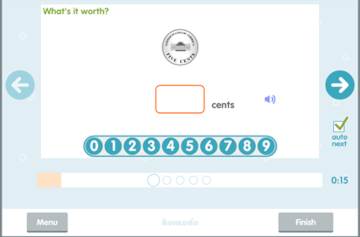Komodo offers supplemental online lessons for math and language arts on a subscription basis for students in kindergarten through fifth grade. You can subscribe to only math or language arts or both, and discounted pricing is available for additional students. There are monthly or yearly subscriptions, and also a 14-day free trial so you can try before subscribing.
It runs through an app that will work on just about any type of device, including phones. Komodo recommends that children spend 15 minutes, four or five days a week on each subject.
Children begin either math or language arts with a short assessment to set the beginning point. Komodo's U.S. staff then customizes the learning plan to suit each student, also accommodating requests that parents might make. This should be especially helpful for children with special needs.
Both math and English programs cover one topic at a time, with progressively more difficult lessons to develop a topic when needed. For each topic, instructional videos are followed by practice exercises. Curiously, the program often gives students two videos at a time. Students can watch one or both before beginning the exercises, or they can skip the videos if they are confident in their knowledge of a topic. However, they occasionally need to watch the video to understand the way some exercises are to be answered. Usually, the same videos are made available before other exercises in the same lesson, so they will have other opportunities to watch them. If students get everything correct within a certain time, earning an A⃰⃰ grade (an A "star" grade is equivalent to an A+) for three exercises in a row, they are given a shortcut up to the next level.
As students work within an exercise set, they can move back to previous problems if they realize they were doing something incorrectly. They are not given feedback on individual problems until they complete a set. They need to get at least 7 out of 10 correct, and the program always alerts them at the end to go back and retry to improve their score, even if they only missed one. When you sign up, Komodo sends a pack with a chart and motivational stickers for parents to award children as they progress. Online, students unlock belts (like martial arts belts) as they progress.
The program has simple animations and is less cluttered with images than many other programs for children. Videos include voice-over instruction, and many exercises include audio components.
Student response methods include clicking on the correct answer, tracing over letters with their mouse or finger for handwriting, writing complete sentences, and typing in the correct numbers, letters, or words. For many exercises, students are provided with selected symbols, letters, numbers, or an entire keyboard on the screen; those with a keyboard attached to their device can either type on the keyboard or select from the onscreen options.
There are no tests or reviews.
Parent Controls
The interface is easy to use, and parents can easily check student progress from their own portal. Parents can print out reports, add daily reminders, and use two-way messaging through the program.
Parents can also change several parameters in the dashboard for each student. They can assign topics, change the amount of time allowed, hide the timer entirely, change the number of A⃰⃰ grades required for a shortcut, and reset lesson grades. I understand that there are customization features for dyslexic and color-blind learners, but I didn’t explore them. Parents can also contact Komodo to ask for help with any accommodations that might be needed.
The parental controls allow parents to streamline the lessons for bright students who can move ahead quickly with less review, making it useful for reinforcing and filling possible gaps for bright students. Leaving the standard settings delivers lots of repetition and practice for students who need that reinforcement instead.
Math
Komodo concentrates heavily on developing fluency with math facts. At the time of this review, lessons related to geometry, measurement, shapes, area, volume, and the coordinate system are under development. Nevertheless, the program does an excellent job reviewing all of the important topics related to basic arithmetic: counting, place value, addition, subtraction, multiplication, division, fractions, decimals, rounding, time telling, word problems, and money.
Math lessons often include visual representations within the exercises to assist students. For example, in lessons on rounding numbers, number lines provide visual clues.
Exercises stay on topic but do not always present the same type of problem. This feature requires students to pay close attention. For example, rounding problems might begin with rounding to the nearest 1000, but intermixed are a few that require rounding to the nearest 10 or 100.
Language Arts
Language arts lessons cover reading, reading comprehension, spelling, vocabulary, writing, and grammar. The program covers all essential topics (aside from oral communication), but many topics are addressed only once or twice within the entire program. This is far less often than students encounter in a comprehensive core curriculum, but remember that the lessons are intended to be supplemental. For example, adjectives are taught in first and second grade, then don’t appear again until a lesson on the order of adjectives at the fifth-grade level. Adverbs are taught in second grade and aren’t addressed again except in a lesson on relative adverbs for fourth grade. Reading lessons begin with the identification of the letters of the alphabet and sound-letter relationships, but there’s not enough repetition to serve as a complete reading program.
I was pleasantly surprised by one unexpected feature: some writing lessons use sophisticated tools to check sentences constructed entirely by students, providing immediate suggestions for corrections that are very accurate.
Summary
Komodo works fine as a supplement that reinforces other instruction. I think it should be especially helpful for students who need more repetition and review than parents have time to provide themselves.








